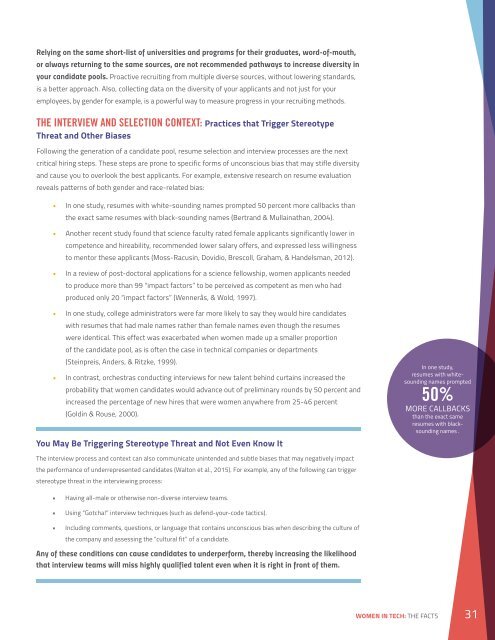WOMEN IN TECH THE FACTS
womenintech_facts_fullreport_05132016
womenintech_facts_fullreport_05132016
Create successful ePaper yourself
Turn your PDF publications into a flip-book with our unique Google optimized e-Paper software.
Relying on the same short-list of universities and programs for their graduates, word-of-mouth,<br />
or always returning to the same sources, are not recommended pathways to increase diversity in<br />
your candidate pools. Proactive recruiting from multiple diverse sources, without lowering standards,<br />
is a better approach. Also, collecting data on the diversity of your applicants and not just for your<br />
employees, by gender for example, is a powerful way to measure progress in your recruiting methods.<br />
<strong>THE</strong> <strong>IN</strong>TERVIEW AND SELECTION CONTEXT: Practices that Trigger Stereotype<br />
Threat and Other Biases<br />
Following the generation of a candidate pool, resume selection and interview processes are the next<br />
critical hiring steps. These steps are prone to specific forms of unconscious bias that may stifle diversity<br />
and cause you to overlook the best applicants. For example, extensive research on resume evaluation<br />
reveals patterns of both gender and race-related bias:<br />
• In one study, resumes with white-sounding names prompted 50 percent more callbacks than<br />
the exact same resumes with black-sounding names (Bertrand & Mullainathan, 2004). <br />
• Another recent study found that science faculty rated female applicants significantly lower in<br />
competence and hireability, recommended lower salary offers, and expressed less willingness<br />
to mentor these applicants (Moss-Racusin, Dovidio, Brescoll, Graham, & Handelsman, 2012).<br />
• In a review of post-doctoral applications for a science fellowship, women applicants needed<br />
to produce more than 99 “impact factors” to be perceived as competent as men who had<br />
produced only 20 “impact factors” (Wennerås, & Wold, 1997).<br />
• In one study, college administrators were far more likely to say they would hire candidates<br />
with resumes that had male names rather than female names even though the resumes<br />
were identical. This effect was exacerbated when women made up a smaller proportion<br />
of the candidate pool, as is often the case in technical companies or departments<br />
(Steinpreis, Anders, & Ritzke, 1999).<br />
• In contrast, orchestras conducting interviews for new talent behind curtains increased the<br />
probability that women candidates would advance out of preliminary rounds by 50 percent and<br />
increased the percentage of new hires that were women anywhere from 25-46 percent<br />
(Goldin & Rouse, 2000).<br />
You May Be Triggering Stereotype Threat and Not Even Know It<br />
In one study,<br />
resumes with whitesounding<br />
names prompted<br />
50%<br />
MORE CALLBACKS<br />
than the exact same<br />
resumes with blacksounding<br />
names .<br />
The interview process and context can also communicate unintended and subtle biases that may negatively impact<br />
the performance of underrepresented candidates (Walton et al., 2015). For example, any of the following can trigger<br />
stereotype threat in the interviewing process:<br />
• Having all-male or otherwise non-diverse interview teams.<br />
• Using “Gotcha!” interview techniques (such as defend-your-code tactics).<br />
• Including comments, questions, or language that contains unconscious bias when describing the culture of<br />
the company and assessing the “cultural fit” of a candidate.<br />
Any of these conditions can cause candidates to underperform, thereby increasing the likelihood<br />
that interview teams will miss highly qualified talent even when it is right in front of them.<br />
<strong>WOMEN</strong> <strong>IN</strong> <strong>TECH</strong>: <strong>THE</strong> <strong>FACTS</strong> 31


